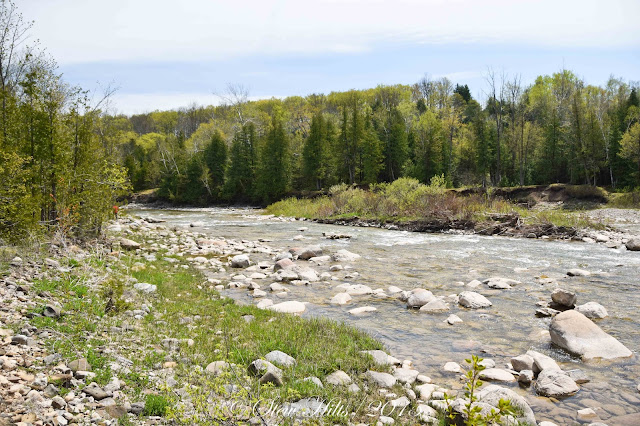Where John Muir worked in 1864-65. The property along the Bighead River on the edge of Meaford on which Trout Hollow sits was recently donated to the Environmental Biosphere Conservancy, one of the largest conservation organizations in this part of Ontario, by the Knight family. Trout Hollow was the sawmill owned by the Trout family where the famous American conservationist John Muir spent a year or two working in 1864-65.
The Trout Hollow Trail starts out on the unused (and sometimes very wet) Sideroad 13 road allowance south of Meaford, and passes through a bit of forest before reaching the Bighead River.
Burcher led us along the rocky shore where I spotted this beautiful Serviceberry in full bloom.
We continued along the riverbank until we could climb up the low bank on the left to the site of Muir's accommodations while he worked at the mill.
Here he told us of how he originally learned that the great John Muir had actually spent two years in this part of Ontario, and how he narrowed down the cabin location until they were able to have an archeological dig.
But there's other evidence too, including this old map which shows the road into the sawmill and the location of two Trout family cabins as well as the sawmill itself.
Not only that, but John Muir completed a sketch of the log cabin himself. Pretty tangible evidence for a historian! I was becoming amazed by this story of Muir in Canada myself by this time.
This tangled mess of fallen trees and branches is the site of the sawmill where Muir worked. Muir was something of an inventor by this time, and he came up with a machine to make the tool handles that the mill specialized in, faster, thus increasing their output. Tragically for the Trout family, the mill burned to the ground in 1865 destroying all their progress, leaving them bankrupt and leaving Muir with no job.
And this is the famous Calypso Orchid that Muir found in the middle of a dense Cedar swamp - the swamp that is now the Holland 'Marsh', a vegetable growing area. John himself described his find, and his slog through the swamp, in a letter to his former professor, J.D. Butler. Butler in turn forwarded the letter to a newspaper in Boston, and it became Muir's very first published writing, written while he was still on his botanical sojourn in southern Ontario. Many years ago I found the Calypso Orchid growing under some Cedars ion Flowerpot Island.
I'll end with a picture of the great conservationist himself, but in the next post I will finish the story of the donation by the Knight family. Trout Hollow is indeed a special place in conservation history and the Knight family deserve a great deal of credit for their donation.
Muir himself headed south through the United States, eventually walking all the way to Florida, working for a time in a wagon wheel factory. After a brief stay in Cuba he arrived back in New York and took a train to San Francisco. He spent the rest of his life there, dedicating himself to nature conservation.














Fascinating! Thise are good people to donate the land.
ReplyDeleteWhat wonderful news. My partner is a proud member of this amazing organization.
ReplyDeleteBeautiful countryside. Great post!!
ReplyDeleteThis was very interesting. I love seeing what you did in your previous life, complete with great pictures!
ReplyDeleteA place well worth preserving.
ReplyDeleteThat is a wonderful history. We were in the Muir Woods on the west coast, back 20 years, methinks.
ReplyDeleteSome pottery pieces washed up along the shoreline of the estuary when we were there last week. Always an interesting find. Love this!
ReplyDeleteInteresting to think that the great conservationist started off by cutting up trees! I look forward to hearing more.
ReplyDeleteIt's always nice to hear when people donate things out of the goodness of their heart and the Trout family is to be commended for their thoughtfulness and generosity. The world needs more conservationists like John Muir.
ReplyDeleteWhat a delight for you and now for us. Was there any effort to increase the habitat of those orchids. There is a conservation area hereabouts where showy ladyslipper orchids grow in abundance.
ReplyDeleteA very interesting post. I'm ashamed to say I've never heard of John Muir. But I'll be sure to do a little review of the internet for materials to read. Thanks.
ReplyDeletei enjoyed the interesting facts you shared today and being reminded of the bruce trail!! i have found pieces of pottery at the oceans shoreline while searching for sea glass!!
ReplyDeleteWhat a fascinating post, thank you.
ReplyDeleteAll the best Jan
Such a generous donation from the Knight family. How wonderful that this treasure will be preserved for generations to come. Great write-up and beautiful photos, as usual.
ReplyDeleteDonations are a great boon to land protection. Hate to have to tell you, but Yosemite wasn't the first national park, Yellowstone National Park was created in 1872 and Yosemite followed in 1890
ReplyDeleteGreat history that you have shared here.
ReplyDelete